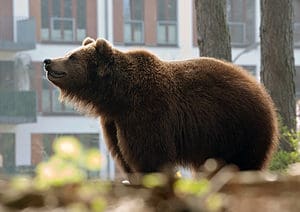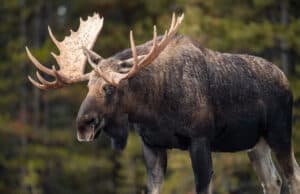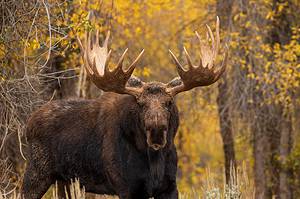When it comes to the question of whether or not moose are nocturnal or diurnal, the answer is a little bit complicated. Moose have been observed being active during the day and night. So, what’s going on? In this blog post, we’ll explore the different sleep habits of moose and what scientists have learned about them. Moose are fascinating creatures, and their sleep patterns are just one more thing that makes them unique. Stay tuned to learn more.
Not Nocturnal, but Moose have a Fascinating Sleep Cycle
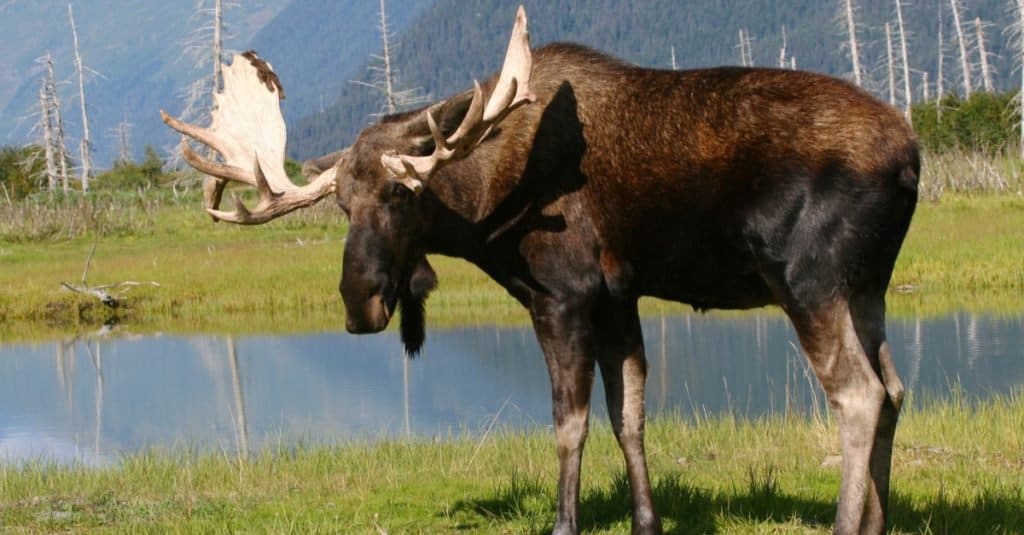
Moose are mainly crepuscular which means that they are active at dawn and dusk.
©Steve Bower/Shutterstock.com
Given their propensity for napping, it’s no surprise that moose are mainly crepuscular creatures. These majestic animals are most active at dawn and twilight when they feed on various plants and grasses. During the day, moose tend to laze about in the shade or nap for short bouts, especially on warm days.
They also tend to sleep irregularly during the night, periodically dozing off and waking up often throughout the dark hours. Despite their peculiar sleeping patterns, these beautiful creatures are endlessly fascinating and well worth observing any time of day. So, if you’re looking to catch a glimpse of these magnificent creatures, do yourself a favor and head out to watch them at dusk or dawn.
Rut Season – An Influence on Moose Activity
According to scientific studies, the changing seasons can significantly impact animal behavior. During the fall months, one of the most striking behaviors to witness is the rut season for moose. During this time frame, which generally occurs in late September to mid or late October, moose can be found out and about during both day and night.
They are highly active during this time, moving quickly across wide open spaces in search of potential mates or new territory. This elevated activity level is primarily a result of hormonal changes as part of their natural reproductive cycle. However, it also stems from environmental factors such as temperature fluctuations and precipitation levels.
Where Do Moose Sleep?
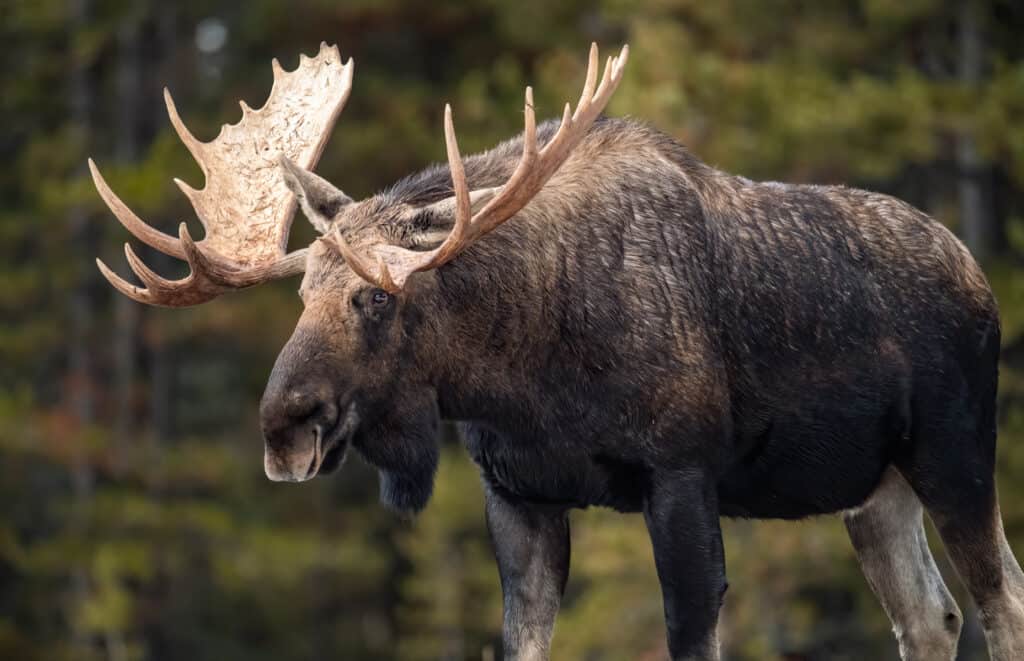
Moose will sleep just about anywhere, including in fields and woodland spaces
©Harry Collins Photography/Shutterstock.com
Despite moose being crepuscular rather than nocturnal, their sleep behavior remains interesting. So, when it comes to where moose sleep, the answer is a bit of a moving target. These creatures are highly adaptable and thrive in various habitats, from dense forests to open meadows. What they value most, however, is shelter from the elements and predators, ideal temperature conditions, and easy access to food. For these reasons, they seek forested areas with water nearby, where they can graze on lush grasses or browse through trees and shrubs for fresh foliage.
Moose certainly make use of established resting spots. Many of these include bedded-down patches of grass or sheltered dens in caves or overhanging rocks. But you may also see them napping practically anywhere they please. Whether by the side of a forest trail or beside someone’s back porch, moose love finding comfortable spots to catch a few winks.
Do Moose Sleep Standing Up?
Regarding the moose’s nocturnal, diurnal, or other sleeping habits, these majestic animals are genuinely unique. They do not need to lie down when it’s time to nap. Instead, they sleep while standing up, with their bodies leaning slightly backward and their heads relaxed. In this semi-conscious state, they can relax while remaining alert and ready to react at a moment’s notice. Moreover, they can even doze in this position for several hours.
While these traits make moose seem somewhat invincible and almost super-human in their ability to survive in the wild, there is a downside to this way of sleeping. Moose can’t go into a deep sleep when their body supports itself upright and they are alert to danger. Therefore, they do need to lie down for a rejuvenating deep sleep from time to time. They generally sleep on their sides when bedding down, with one antler on the ground and their legs, either tucked up close or extended.
Do Moose Hibernate in Winter?
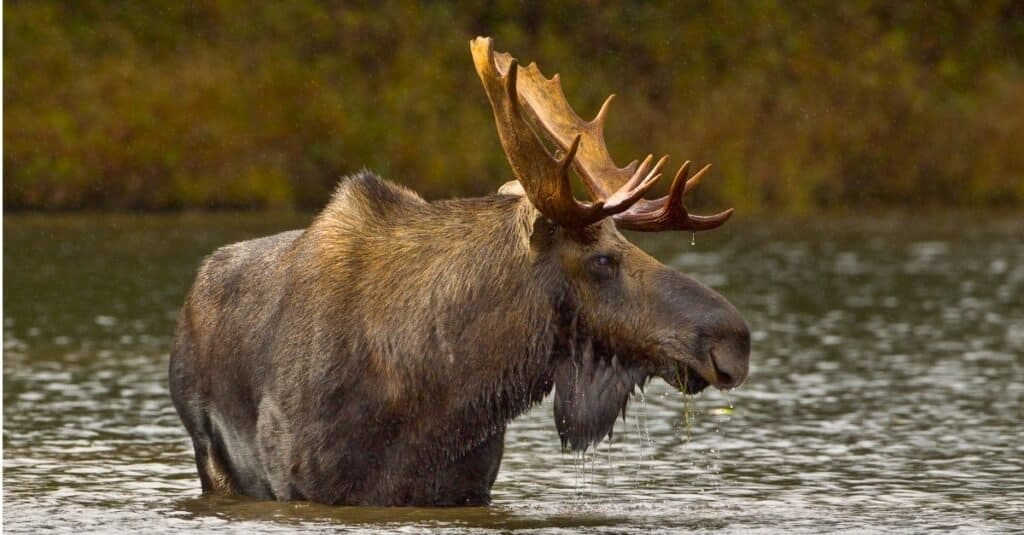
Moose are well adapted to survive the harsh winter weather
©iStock.com/RichardSeeley
Moose do not hibernate during the winter. Instead, they have physical adaptions to the seasonal changes in their natural habitats. Powerful muscles and thick fur equip these large animals perfectly to endure even the coldest temperatures. Their long nasal passages help to warm and humidify the air. At the same time, their energy-efficient bodies allow them to conserve energy for activities critical for survival. These critical activities include foraging in the snow and ice for food, remaining alert to predators, and reproduction. Overall, moose are resilient creatures with a remarkable ability to adapt even in the harshest environments.
Moose Eyes Are Not Designed For Nocturnal Excursions
Unfortunately, moose do not have good eyesight. However, while moose vision may be poor compared to humans or other animals, they have adapted other means to navigate their environments. Moose rely on other senses, particularly their powerful sense of smell and acute hearing, to detect predators and evade danger.
In addition, they are pretty good at detecting even the smallest number of stimuli in their environment. This extra tool lies in the dense array of sensory cells that line their muzzles. Thanks to these keen senses, moose can effectively experience the world around them despite having an almost non-existent ability to see things far away. Due to this flexibility, these senses ensure they are adept at dodging a predator. This innate talent for sensing danger shows how these magnificent creatures demonstrate impressive survival skills despite their lack of clear vision.
Moose Eye Structure: Not Nocturnal, But Reflective
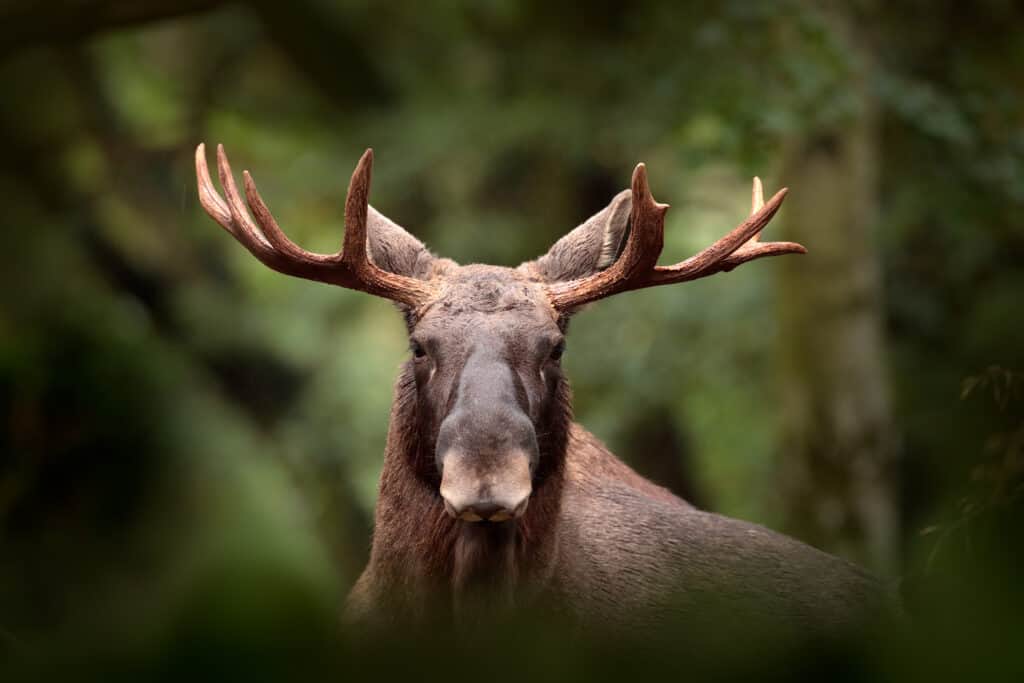
Moose are not well adapted to seeing in the dark, instead they rely on their acute hearing and sense of smell.
©iStock.com/Ondrej Prosicky
Regarding their eye structure, moose are color-blind due to a shortage of eye cones. However, their eyes are highly reflective, allowing them to utilize what vision they have to see even in the dark. This ability is made possible by a particular layer in the retina known as a tapetum lucidum – a mirror reflecting light through the retina. This mirrored layer often causes moose eyes to glow when they reflect light from car headlights. Although night drivers may notice this reflection, sadly, this is more often not the case.
Nocturnal Moose Behavior and People
Despite their impressive eye structure, moose can be notoriously tricky to spot at night due to their size and stature. As many drivers know all too well, even though moose are not nocturnal, they often cross over roads at night. This behavior is a problem as these large animals can go unnoticed in the light beams of headlights due to their exceptional height.
Their reflective eyes are higher than the headlights and, therefore, not easily seen. This situation often leads to human fatalities and injured moose. But with some care and attention, we can help these magnificent creatures and ourselves stay safe during their twilight explorations. What better way than understanding their sleep and activity and then using that knowledge to protect moose in their natural environment?
Nocturnal vs. Diurnal: What’s The Difference?
Navigate to Nocturnal vs. Diurnal: What’s The Difference? for further information about the nocturnal and diurnal phenomenon in various living creatures.
Next Up – All About Moose
- The Largest Moose In The World
- Impossibly Rare White Moose Looks Straight Out of Lord of the Rings
- 10 Incredible Moose Facts
- Moose Vs. Deer: What Are the Differences?
The photo featured at the top of this post is © Steve Bower/Shutterstock.com
Sources
- JSTOR, Available here: https://www.jstor.org/stable/1376569
- BES Journals, Available here: https://besjournals.onlinelibrary.wiley.com/doi/full/10.1111/1365-2656.12000
- Research Gate, Available here: https://www.researchgate.net/publication/8906264_Comparative_morphology_of_the_tapetum_lucidum_among_selected_species
Thank you for reading! Have some feedback for us? Contact the AZ Animals editorial team.



